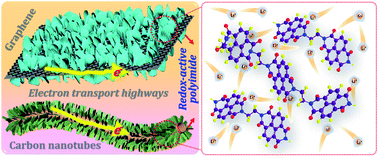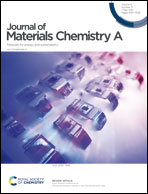In situ growth of polyimide nanoarrays on conductive carbon supports for high-rate charge storage and long-lived metal-free cathodes†
Abstract
Redox-active carbonyl polymers have been intensively explored as promising high-capacity cathode alternatives to traditional inorganic materials for metal-ion batteries. Despite inspiring achievements, practical implementation is severely restricted by their intrinsic electronic insulation and insufficient utilization of carbonyl active sites. Herein, an efficient hydrothermal polycondensation of dianhydride and diamine co-monomer salts was readily performed in the presence of graphene oxide and carbon nanotubes (CNTs) to generate graphene sheet-sandwiched and CNT-encapsulated polyimide (PI@GS and PI@NT, respectively). The in situ heterogeneous nucleation process under hydrothermal conditions allows for intimate contact between densely interconnected PI nanoflakes and conductive carbon supports, forming robust 3D hierarchical nanoarchitectures with abundant porous channels and highly exposed redox-active sites of carbonyl groups. When used as cathodes, PI@GS and PI@NT show characteristics of surface-dominated capacitive behavior via fast kinetics due to high-speed electron transport, facile electrolyte penetration, and fast ion diffusion. Typically, the PI@GS cathode exhibits remarkable electrochemical performance with an efficient carbonyl utilization ratio (90%), high specific capacity (165 mA h g−1 at 0.1C), superior rate capability (125 mA h g−1 at 20C), and long cycling stability (88% retention at 5C after 5000 cycles), significantly outperforming its PI counterpart and reported polymer cathodes. Stable Na-ion storage performance was also observed in the PI@GS cathode. This work crafts an unconventional approach to engineering organic/inorganic building blocks into metal-free heteroarchitectures to unlock the barrier of low utilization ratio of redox-active groups toward high-rate energy storage, and may offer new insights into developing low-cost and long-lived organic electrode materials for more powerful and sustainable batteries.



 Please wait while we load your content...
Please wait while we load your content...